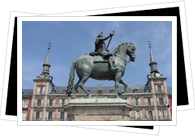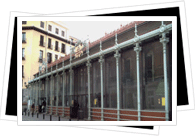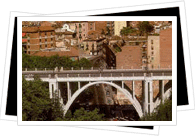Plaza Mayor, Madrid - Los Austrias / Hapsburg Madrid
- Calle Mayor
- Plaza Mayor
- Mercado de San Miguel
- Plaza de la Villa
- Muralla Árabe
- Catedral de la Almudena
- Palacio Real
- Plaza de Oriente
- Puente de Segovia
- Basílica de San Francisco el Grande s
- Plaza de San Andrés
- Cava Baja & Around
Hapsburg Madrid is the oldest section of the city, so it's logically packed with the most historical attractions. A good place to start is Calle Mayor, which meets the southwest corner of Puerta del Sol. Calle Mayor is one of Madrid's oldest streets, but instead of continuing all the way down, first duck into any of the Plaza Mayor's many entrances on the southern side of the street.
 The site where the Plaza Mayor now stands was originally utilized as an outdoor produce market in the Middle Ages. Since the first building was erected in 1580, however, it has also catered bullfights, autos de fe and royal ceremonies. Over the years it burned down so many times that few if any of the buildings standing date further back than 1790. The Casa de la Panadería, first constructed in 1590, is the tallest and most interesting element. Royals used to observe gatherings from its tallest balconies. Strangely, the colorful allegories now covering the facade date all the way back to...1992.
The site where the Plaza Mayor now stands was originally utilized as an outdoor produce market in the Middle Ages. Since the first building was erected in 1580, however, it has also catered bullfights, autos de fe and royal ceremonies. Over the years it burned down so many times that few if any of the buildings standing date further back than 1790. The Casa de la Panadería, first constructed in 1590, is the tallest and most interesting element. Royals used to observe gatherings from its tallest balconies. Strangely, the colorful allegories now covering the facade date all the way back to...1992.
These days, the Plaza Mayor serves as Madrid's grand square, busy with foot traffic all year-round but especially over Christmas. Families take their children to see nativity scenes and madrileños of all ages buy wacky wigs sold around the plaza. The Christmas wigs have no religious or cultural significance -- Spaniards just seem to like them. There's also a tourist office right on the square and numerous overpriced, touristy restaurants with outdoor seating perfect for people-watching.
 Return to Calle Mayor, walking westward away from Sol, and you'll pass the Mercado de San Miguel (c. 1913) on your left. About a block down on the same side is Madrid's oldest square, Plaza de la Villa. The plaza's principal building, Casa de la Villa, has housed the Ayuntamiento de Madrid (City Hall) since 1696. Even older are the Casa de Cisneros (1537) and Casa y Torre de los Lujanos (1494).
Return to Calle Mayor, walking westward away from Sol, and you'll pass the Mercado de San Miguel (c. 1913) on your left. About a block down on the same side is Madrid's oldest square, Plaza de la Villa. The plaza's principal building, Casa de la Villa, has housed the Ayuntamiento de Madrid (City Hall) since 1696. Even older are the Casa de Cisneros (1537) and Casa y Torre de los Lujanos (1494).
Our tour of ancient Madrid continues to the end of Calle Mayor, crossing Calle Bailén and directly down Cuesta de la Vega. Here you'll find a section of the Muralla Árabe, one of the rare surviving artifacts of Islamic Madrid. Don't expect much - a small section dates to the 9th century and another to the 12th, when Madrid was under early Christian rule.
The Arab Wall faces the Cathedral de la Almudena, so head back up Cuesta de Vega and turn left to find the main entrance. Just past the Cathedral is the much more noteworthy Palacio Real. (See other Madrid museums for information about the Royal Palace's interior). The elegant square in front of the Palacio is Plaza de Oriente, with the Teatro Real - Madrid's official opera house - as its focal point.
 The Palacio Real is on Calle Bailén. Retrace you steps towards Calle Mayor and over the Viaducto de Segovia, which suspends Bailén high over Calle Segovia and makes it easy to reach the Iglesia de San Francisco el Grande on the other side. Saint Francis of Assisi supposedly founded the church himself in 1217.
The Palacio Real is on Calle Bailén. Retrace you steps towards Calle Mayor and over the Viaducto de Segovia, which suspends Bailén high over Calle Segovia and makes it easy to reach the Iglesia de San Francisco el Grande on the other side. Saint Francis of Assisi supposedly founded the church himself in 1217.
From here, head up Carrera de San Francisco. Above lies the most happening part of Hapsburg Madrid, La Latina. On your left, the Plaza de San Andrés is a traditional meeting point for outdoor Sunday drinking. Continue on to Cava Baja, packed with great restaurants and fashionable bars. You'll stumble upon one great locale after the next around here, along with picturesque, colorful, winding streets.
This area also hosts the major Madrid festivals of San Isidro and La Paloma.
